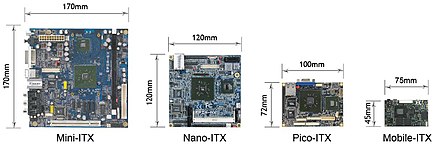
Mobile-ITX is the smallest (by 2009) x86 compliant motherboard form factor presented by VIA Technologies in December, 2009. The motherboard size (CPU module) is 60 × 60 mm (2.4 × 2.4 in).[1] There are no computer ports on the CPU module and it is necessary to use an I/O carrier board. The design is intended for medical, transportation and military embedded markets.
History
[edit]
The Mobile-ITX form factor was announced by VIA Technologies at Computex in June, 2007. The motherboard size of first prototypes was 75 × 45 mm (3.0 × 1.8 in).[2] The design was intended for ultra-mobile computing such as a smartphone or UMPC.
The prototype boards shown to date include a x86-compliant 1 GHz VIA C7-M processor, 256 or 512 megabytes of RAM, a modified version of the VIA CX700 chipset (called the CX700S),[3] an interface for a cellular radio module (demonstration boards contain a CDMA radio), a DC-DC electrical converter, and various connecting interfaces.
At the announcement, an ultra-mobile PC reference design was shown running Windows XP Embedded.[4]
Notes and references
[edit]- ^ "VIA Mobile-ITX Brings Further Miniaturization and Greater Flexibility to Embedded Devices". VIA Technologies, Inc. 2009-12-01. Archived from the original on 2009-12-05.
- ^ "VTF2007: VIA Mobile-ITX Mainboard Will Expedite PC2.0 Transition". Taipei, Taiwan: VIA Technologies, Inc. 2007-06-06. Archived from the original on 2008-11-20. Retrieved 2008-10-08.
- ^ "Mini-ITX, Nano-ITX and Pico-ITX related news - VTF 2007 - Next Stop: Mobile-ITX". Archived from the original on 2007-07-23. Retrieved 2007-06-12.
- ^ YouTube - Computex 2007 - Mobile-ITX Demo
External links
[edit]
Well, that’s interesting to know that Psilotum nudum are known as whisk ferns. Psilotum nudum is the commoner species of the two. While the P. flaccidum is a rare species and is found in the tropical islands. Both the species are usually epiphytic in habit and grow upon tree ferns. These species may also be terrestrial and grow in humus or in the crevices of the rocks.
View the detailed Guide of Psilotum nudum: Detailed Study Of Psilotum Nudum (Whisk Fern), Classification, Anatomy, Reproduction